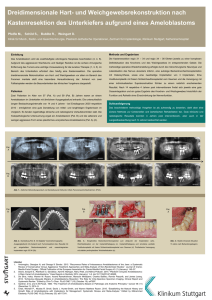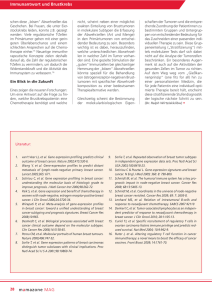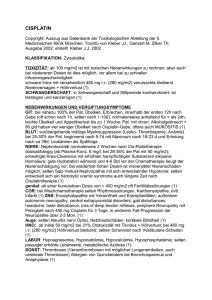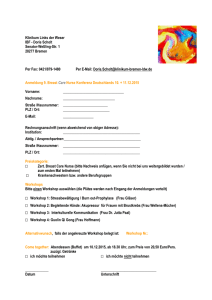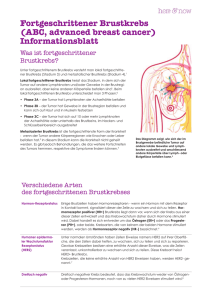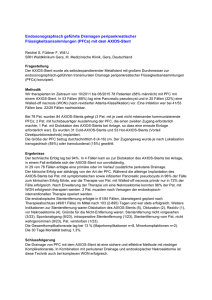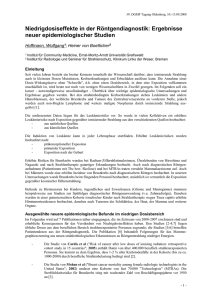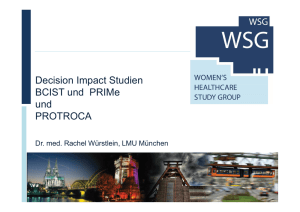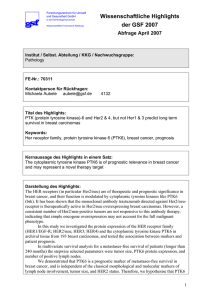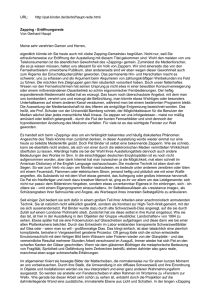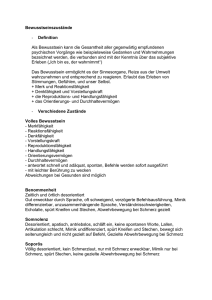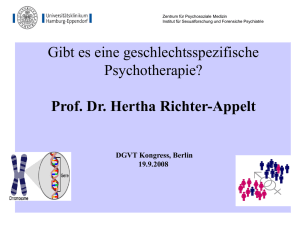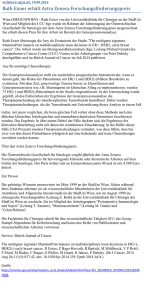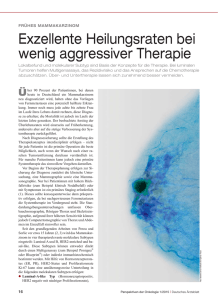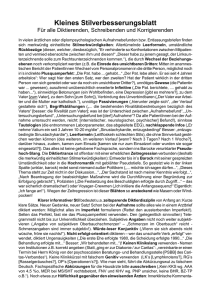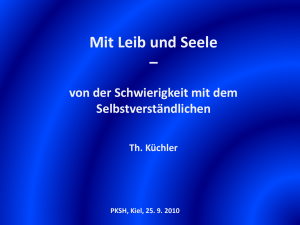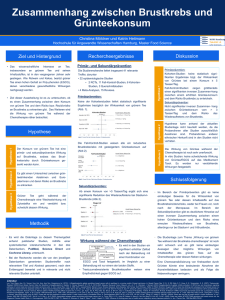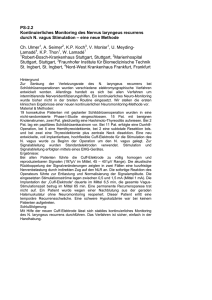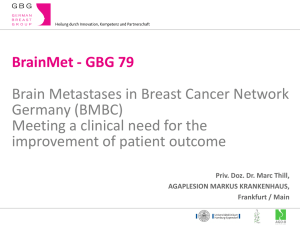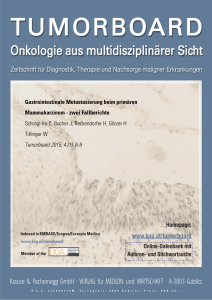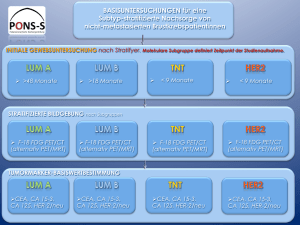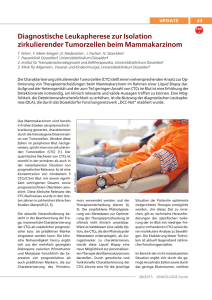San Antonio Breast Cancer Symposium 2008 – Beiträge von
Werbung
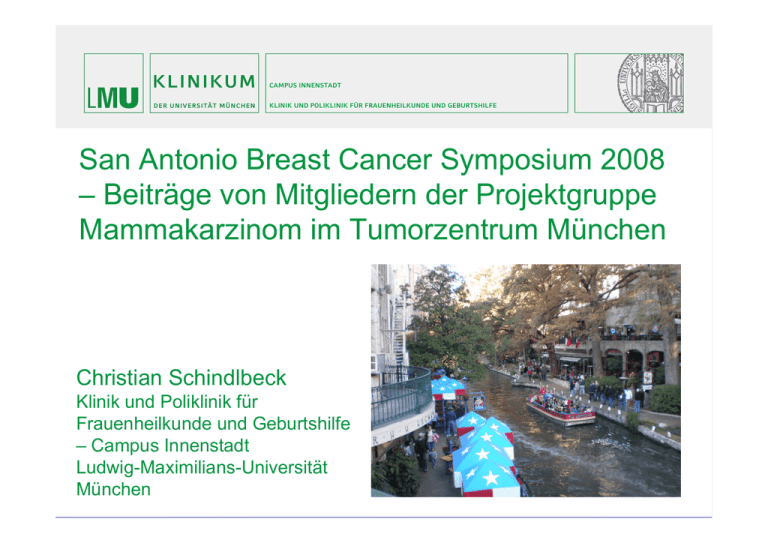
CAMPUS INNENSTADT KLINIK UND POLIKLINIK FÜR FRAUENHEILKUNDE UND GEBURTSHILFE San Antonio Breast Cancer Symposium 2008 – Beiträge von Mitgliedern der Projektgruppe Mammakarzinom im Tumorzentrum München Christian Schindlbeck Klinik und Poliklinik für Frauenheilkunde und Geburtshilfe – Campus Innenstadt Ludwig-Maximilians-Universität München CAMPUS INNENSTADT KLINIK UND POLIKLINIK FÜR FRAUENHEILKUNDE UND GEBURTSHILFE 22 Beiträge von Mitgliedern der Projektgruppe (www.SABCS.org) 4 Vorträge unter Mitwirkung von Mitgliedern der PG Ein Hauptvortrag (Prof. Eiermann) 16 Posterpräsentationen 2 Poster Discussions 2 Posterpreise BCIRG 005 (Abstract # 77) BCIRG 005 main efficacy analysis: a Phase III randomized trial comparing docetaxel in combination with doxorubicin and cyclophosphamide (TAC) versus doxorubicin and cyclophosphamide followed by docetaxel (AC-T) in women with HER2 normal and axillary lymph node positive early breast cancer Eiermann W, Pienkowski T, Crown J, Chap L, Pawlicki M, Martin M, Chan A, Saleh M, Sehdev S, Provencher L, von Minckwitz G, Semiglazov V, Slamon D, Tabah-Fisch I, Buyse M, Riva A, Taupin H, Sauter G, Mackey J, on behalf of the BCIRG 005 investigators. Study sponsored by Sanofi-Aventis, TAX GMA 301 BCIRG 005 Design 4 x AC 4 x Docetaxel 60/600 mg/m2 R HER2 normal (FISH) 100 mg/m2 6 x TAC 75 / 50 / 500 mg/m2 N= 3298 Stratification: • Nodes: 1-3 4+ • HR+/• Center Dexamethasone premedication, 8 mg bid, 3 days Prophylactic ciprofloxacin 500 mg bid, day 5-14 BCIRG 005 Overall Survival – Primary Analysis 1.0 88.9% Survival probability 0.9 88.1% 0.8 0.7 0.6 TAC AC 0.5 T Total Patients Events 1649 202 1649 187 3298 389 Logrank p=0.37 HR = 0.91 (95% CI, 0.75-1.11) 0.4 0 12 24 36 48 Months 60 72 84 96 BCIRG 005 Conclusions 1. For the primary endpoint, DFS, adjuvant TAC is equivalent to AC-T in patients with HER2 normal, node + breast cancer 2. Despite AC-T delivering higher dose intensity for each of the three agents and requiring 8 cycles, AC-T was not more effective than TAC 3. Compared to AC-T, TAC is associated with: more febrile neutropenia and GCSF use but no increased incidence of infections less sensory neuropathy, nail change, myalgia and shorter duration of therapy CAMPUS INNENSTADT KLINIK UND POLIKLINIK FÜR FRAUENHEILKUNDE UND GEBURTSHILFE (#31) CAMPUS INNENSTADT KLINIK UND POLIKLINIK FÜR FRAUENHEILKUNDE UND GEBURTSHILFE CAMPUS INNENSTADT KLINIK UND POLIKLINIK FÜR FRAUENHEILKUNDE UND GEBURTSHILFE CAMPUS INNENSTADT KLINIK UND POLIKLINIK FÜR FRAUENHEILKUNDE UND GEBURTSHILFE CAMPUS INNENSTADT KLINIK UND POLIKLINIK FÜR FRAUENHEILKUNDE UND GEBURTSHILFE CAMPUS INNENSTADT KLINIK UND POLIKLINIK FÜR FRAUENHEILKUNDE UND GEBURTSHILFE (#79) (#78) (N+, 1-3 LKs) (#3091) Kiechle M, Engel C, Schwarz-Boeger U, Grund D, Preisler-Adams S, Crohns C, Stark S, Gadzicki D, Strunz K, Schoenbuchner I, NestleKräemeling C, Kast K, Ditsch N, Schlehe B, Schmutzler R Impact of BRCA mutation status on the clinical phenotype and survival of hereditary breast cancer. Ergebnisse: •Pat mit BC/OC: 566 hatten BRCA1 und 313 BRCA2 mutation. •Pat mit BRCA-1 Mutation hatten signifikant häufiger einen Hormon Rezeptor negativem Tumor und Grad 3, sowie medullärem Subtyp •Diagnosealter signifikant niedriger bei Mutationsträgerinnen •BRCA2 Mutation häufiger bei N+ (46%, BRCA-1: 32%, p<0.01), jedoch kein Unterschied im Überleben zwischen BRCA1 and BRCA2 Mutationsträgerinnen •Insgesamt schlechteres Überleben bei Mutationsträgerinnen Artmann A, Celik K, Kiechle M, Rummeny EJ, Schmitt M, Harbeck N Concentrations of plasminogen activator inhibitor type1 (PAI-I) and urokinase-type plasminogen aktivator (uPA) in primary breast cancer (BC) tissue and corresponding axillary lymph node metastasis (#2046) Hintergrund Urokinase-type plasminogen activator (uPA) und -inhibitor (PAI-1) sind signifikante Prognosefaktoren des primären Mammakarzinomes Material and Methodik Korrelations zwischen uPA and PAI-1 Konzentrationen in 73 Primärtumoren und korrespondierenden axillären LKs von pN0 und pN+ Pat. (1991-98), Zusammenhang mit FU Ergebnisse: In befallenen axillären LKs (pN+) war die Konzentration von PAI-1, aber nicht von uPA, signifikant höher als in pN0 Pat. (p < 0.001). Pat., bei denen die axillären LKs höhere PAI-1 Konzentrationen im Vergleich zum Primärtumor aufwiesen, hatten ein kürzeres DFS (p < 0.001) und OS (p = 0.005) Thomssen C, Vetter M, Geurts-Moespot A, Kantelhardt EJ, Veyret C, Schmidt M, Meisner C, von Minckwitz G, Hanf V, Martin P, Augustin D, Abraha-Späth SR, Schmitt M, Sweep F, Paepke D, Harbeck N Determination of ASCO recommended prognostic factors uPA and PAI-1 in daily clinical routine and the node-negative NNBC 3-Europe trial (# 1092) Vergleich uPA / PAI-1 Bestimmung Primärtumor / Stanze: 95 % Übereinstimmung (n=42) Risk Assessment bei 2360 Pat. (Grading, uPA / PAI-1) Weissenbacher TM, Zschage M, Janni W, Scholz C, Sommer H Multicentric/-focal vs. unifocal breast cancer: is the TNM-classification justified? (# 2075) In das Tumorstadium pT geht bisher nur der größte Tumordurchmesser ein, nicht jedoch Multifokalität bzw. das Gesamt-Tumorvolumen Methodik: Matched-pair Analyse von je 288 Pat (1963-2007), med. FU (5,8 Jahre, range 19 – 312 mon) Ergebnisse: Sign. verkürztes DFS und OS (med. 221.6 mon, 206.7 – 236.4, vs 203.3 mon, 184.1 – 222.5, 95% CI, p< .0001) bei Pat. multifokalem Ca TNM unter Einbeziehung des Tumorvolumens bzw. Multifokalität Schindlbeck C, Rack B, Jueckstock J, Schneeweiss A, Thurner-Herrmanns E, Schneider A, Rezai M, Beckmann M, Pantel K, Lichtenegger W, Sommer H, Friese K, Janni W, Chatsiproios D Prognostic relevance of circulating tumor cells (CTCs) in peripheral blood of breast cancer patients before and after adjuvant chemotherapy translational research program of the German SUCCESS-trial (Poster discussion session, # 303) AACR Susan G. Komen Scholar in training Award SUCCESS-Study Design (Simultaneous Study of Docetaxel-Gemcitabine Combination adjuvant treatment, as well as Extended Bisphosphonate and Surveillance-Trial ) R R Endocrine Treatment: Translationales Forschungsprogramm: Blutabnahme vor / nach CTX, nach 2 und nach 5 Jahren Schindlbeck C, Rack B, Jueckstock J, Schneeweiss A, Thurner-Herrmanns E, Schneider A, Rezai M, Beckmann M, Pantel K, Lichtenegger W, Sommer H, Friese K, Janni W, Chatsiproios D Prognostic relevance of circulating tumor cells (CTCs) in peripheral blood of breast cancer patients before and after adjuvant chemotherapy translational research program of the German SUCCESS-trial (# 303) Methodik: Bestimmung von Zirkulierenden Tumorzellen (CTCs) mit Hilfe des CellSearch Systems (Veridex): Immunomagnetische Anreicherung, Fluoreszenzfärbung auf Zytokeratin, DAPI, CD45, automatisiertes Screening) Ergebnisse: bisher Auswertung von 1500 Pat vor und nach CTX. Positivität bei 10% bzw. 9%. Korrelation von CTCs nur mit Nodalstatus (p=0,003) Follow-up (med. 14.2 mon, 0-28) 21 Rezidive, 7 Todesfälle CTCs nach CTX signifikant für DFS (p=0,04) und OS (p=0,03) Jenderek C, Jückstock J, Schindlbeck C, Rack B, Fuchs R, Noeding S, Krabisch P, Ebner F, Lichtenegger W, Beckmann MW, Friese K, Sommer H, Janni W Minimal residual disease detection in peripheral blood of primary breast cancer patients translational research in the SUCCESS-study. (# 5019) Methodik: Anreicherung von CTCs mittels OnkoQuick, Zytospin-Präparation, manuelles Screening Ergebnisse: 1237 Pat vor, 655 nach CTX Positivität PB (CTCs) vor CTX: 20.3% , nach CTX: 15,7 % Korrelation CTCs nach CTX mit HER2 Positivität (p=0,08) Manuelles Screening geeignet zum Nachweis von CTCs Hepp PGM, Rack BK, Mouarrawy D, Groh U, Graf H, Göhler T, Finas D, Hönig A, Lichtenegger W, Sommer H, Janni W CA 27.29 as a tumour marker for risk evaluation and therapy monitoring in patients with primary breast cancer. (#2004) •Bestimmung des Tumormarker CA27.29 (MUC-1 für AIA600II, Tosoh, Belgien) bei 2669 Pat. vor und nach CTX im Rahmen der SUCCESS-Studie •9% der Pat vor und 21% der Pat. nach CTX hatten erhöhte CA 27.29 Werte (p<0,0005) •Korrelation CA27.29 mit Tumorgröße (p<0.020) und Nodalstatus (p<0.022) •Kein Unterschied des CA27.29 Wertes zwischen den Therapiearmen vor Chemotherapie, jedoch hinterher: erhöhte Werte bei 12% im FEC-Doc Arm, jedoch bei 22% im FECDocG Arm Rack BK, Janni W, Genss E, Schneeweiss A, Rezai M, Hilfrich J, Lorenz R, Chatsiproios D, Schneider A, Sommer H, Lichtenegger W, Beckmann MW, Friese K Toxicity analysis of a phase III study evaluating FEC-Doc vs. FEC-Doc in combination with gemcitabine as adjuvant treatment for breast cancer the SUCCESS-trial (#4108) •Therapieabbruch nicht sign. unterschiedlich zwischen beiden Armen •Dosisreduktion >20% (3.97% vs 2.90%) und Zyklusverschiebung >7die (22,85% vs 14.19%) häufiger im FEC-DG arm (p< .001). •G-CSF Gabe bei 850 (29.2%) vs. 602 Pat (20.7%, p< .001) im FEC-DG Arm •Afebrile und febrile Neutropenie und Anämie nicht unterschiedlich, aber Thrombocytopenie häufiger bei FEC-DG (1.7%, p= .007). •Hand-Fuß Syndrom und Neuropathie häufiger im FEC-D Arm (p= .09 und p= .02). Jückstock JK, Rack BK, Schindlbeck C, Hofmann S, Zill BJ, Mylonas I, Blankenstein T, Janni WJ, Friese K Treatment with trastuzumab in recurrence free patients with early breast cancer and persistent disseminated tumor cells (DTC) in bone marrow. (#3135) AACR AstraZeneca International Scholar-in-training Award Diskonkordanz biologischer Faktoren zwischen Primärtumor und DTZ / CTCs, z. B. HER2 Therapeutischer Effekt von Trastuzumab auf HER2 pos DTZ? •129 Pat mit DTZ im rezidivfreien FU. 38 % mit HER2-pos DTZ •Konkordanz zum Primär-TU 68 % •12 Pat. erhielten Hercept., bei 5 waren nach Therapie keine DTZ mehr nachweisbar? •Reduktion der Zellzahl statist. sign. (p=0,051) Solomayer E, Gebauer G, Hirnle P, Janni W, Lück H-J, Becker S, Huober J, Kraemer B, Wackwitz B, Fehm T Influence of zoledronic acid on disseminated tumor cells (DTC) in primary breast cancer patients (# 2048) •96 Pat., bei 76 DTZStatus vor und nach Therapie •Reduktion der Anzahl von DTZ in beiden Gruppen, als Trend häufiger in der ZolGruppe (p=0,066) •Pat. nach Zoledronat Behandlung zeigten häufiger negatives KM (66,7 % vs 35,1 %) Braun S, Naume B, Mueller E, Janni W, Marth C, Gnant MF, on behalf of ABCSG21 Investigators Results of the randomized phase II trial of adjuvant anastrozole versus anastrozole plus fulvestrant in hormonereceptor-positive postmenopausal breast cancer patients with bone marrow micrometastasis (ABCSG trial 21). (#4159) Postmenop., Rezeptor-pos., HER2 neg. Pat, CTX abgeschlossen Pat mit DTZ zur Randomisation Anastrozol Fulvestrant •Kalkuliert: 15-20% der Pat mit DTZ 880 Pat. erforderlich •Von 278 gescreenten Pat nur 17 mit DTZ, nur 13 (4,7 %) einzuschließen Studie abgebrochen •Alle 13 Pat. hatten neg. KM nach 1 Jahr, unabh. von Therapie Naume B, Fehm T, Wiedswang G, Jückstock J, Borgen E, Rack B, Synnestvedt M, Braun S, Sommer H, Solomayer E, Pantel K, Friese K, Janni W Persistence of isolated tumor cells in the bone marrow of breast cancer patients predicts increased risk for relapse a European pooled analysis (Poster discussion, #304) •Prognostische Bedeutung von DTZ. auch im Rezidivfreien FU •723 pts aus Oslo (n=356), München (n=228) und Tübingen (n=139) med. 31.7 Mon. nach Primärdiagnose •Positivität für DTZ 15,5% •Präsenz von DTZ sign. Prognosefaktor (RR 3.42, 1.64 7.13 95% CI, p= .001) für reduz. DFS und OS (P<0,001) Kahlert S, Rosenfeld J, Mair K, Sorokina Y, Engel J, Friese K Adjuvant chemotherapy for breast cancer - prognostic impact of relative dose-intensity (#4109) •Schlechtere Prognose bei Dosisreduktion <80% •887 Pat., med. FU 70 mon., 260 Fernmetastasen, 234 Todesfälle •193 x CMF, 442 x norm. A, 252 x hiA, 302 x Taxane. •Rel DI waren 90% (CMF), 93% (norA) und 92% (hiA) •Univariaten Analyse: 5 Jahres DDFS (74% vs. 55%, p=0.002) und OS (80% vs. 65%, p=0.009) reduziert bei Pat mit DI < 80%. Dieser Effekt war am ausgeprägtesten bei Pat. mit norm. Anthrazyklindosis Kahlert S, Mainka P, Knall E, Bauer K, Mayr D Efficacy of palliative chemotherapy for metastatic breast cancer according to HER2-status and basal cytokeratin expression. (#6123) •240 pts., 455 CTX Linien (240 1st line, 114 2nd line, 53 3rd line and 48 4th line). •Regimes: Anthracycline (44%), Taxane (27%), Vinca alkaloide (15%), Capecitabine (8%), Platinumsalze (4%), trastuzumab (15%). 43% Kombinationstherapien. •IHC bzw. FISH (Her2) auf ER, PR, Her2 und basale Zytokeratine CK 5/6 und CK14. •Gruppen: ER/PgR+ (46%), HER+ (28%), non-basal (10%) and basal (16%). •OS in der Basal-Zell Gruppe war sign. kürzer (10.7m) im Vergleich zu and. Gruppen (non-basal 23.7, HER+ 22.0 and ER/PgR+ 28.1 mo., p=0.001). •Time to treatm. failure (TTF): 2.1 (basal), 4.0 (non-basal), 5.5 (HER+), 5.7 (ER/PgR+). Warm M, Kates R, Overkamp F, Zaun SG, Harbeck N Results of the German fulvestrant in practice evaluation programme to evaluate the efficacy, safety, tolerability and acceptance of fulvestrant under daily routine conditions. (#6132) •848 postmenopausale Frauen ER+, metast Mamma-Ca •Med. Alter 64 J., 52 % mit Co-Morbidität, 78 % eine oder mehr palliative Therapien. •Median 4 Vortherapien. •Ansprechen bei 627 / 848 Pat., 62 Komplett- und 177 partielle Remissionen •9-month overall survival (OS) 89%; 9-month event-free survival (EFS) 71% •84 Todesfälle, 7 SAEs •Wenig Nebenwirkungen, gute Akzeptanz Schwarz-Boeger U, Zahlmann G, Paepke S, Schmidt M, Jacobs VR, Kiechle M, Harbeck N The benefit using an integrated electronic trial platform for a neoadjuvant therapy trial (HEDON) in primary breast cancer results of an evaluation study. (# 3114) •Kooperation RdI / Siemens zum Aufbau einer Datenmanagement-Systems für klinische Studien •Anwendung im Rahmen der HEDON-Studie (Herceptin-Docetaxel Neoadjuvant), n=90 •Automatischer Datentransfer zwischen Krankenhaus-Informationssystem und elektr. CRF •Zeitersparnis gegenüber Papierversion: 27 % Jacobs VR, Braun M, Harbeck N, Wagenpfeil S, Sattler D, Bernard R, Kuhn W, Nitz U, Ihbe-Heffinger A Prospective cost analysis from the provider`s perspective: pharmaco-economic results from AGO-WSG intergroup adjuvant EC DOC trial vs. CMF in nodal-positive breast cancer and its reimbursement •Phase III WSG-AGO Intergroup EC DOC trial: EC-DOC vs CMF vs FEC (s. Nitz) •110 pts, 38 Zentren, 1047 Chemotherapie-Zyklen •EC-Doc: 8459 € Zytostatika: 5673€; 67%. Personal: 1357€ (16.0%), Klinik 414€ (4.9%), Port, Diagnostik etc 376€ (4.4%), Supportivmaßn. 354€ (4.2%), Rehospitalisation (n=7) 313€ (3.7%). •CMF: 4973 € Kostensteigerung durch neue Therapien, Unterfinanzierung durch GKV Lux MP, Benedict A, Buchholz S, Woeckel A, Harbeck N, Kreienberg R, Kaufmann M, Beckmann MW, Jonat W, Hadji P, Distler W, Raab G, Tesch H, Weyers G, Schneeweiss A, Possinger K Cost-effectiveness of anastrozole versus tamoxifen as adjuvant therapy in early breast cancer (EBC) a German health economic analysis (#6109) Pharmakoökonomische Untersuchung basierend auf der 100-MonatsAnalyse der ATAC-Studie Kosten pro Quality adjusted life year (QALY) durch Anastrozol 20000 - 30000€ Anastrozol = Kosteneffektive Therapie CAMPUS INNENSTADT KLINIK UND POLIKLINIK FÜR FRAUENHEILKUNDE UND GEBURTSHILFE Vielen Dank!
